
JOIN THE REVOLUTION IN BOSTON
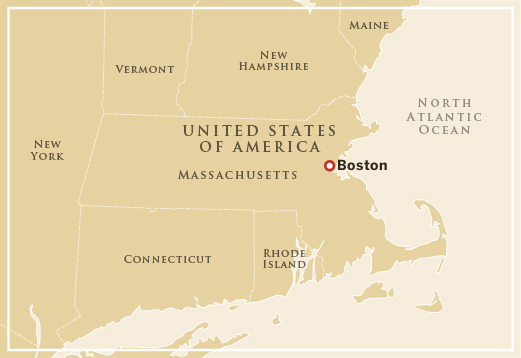
Take the family to Boston to discover the daring and defiance of America’s fiery forebears. Just don’t be surprised if your children start to make demands like ‘Give me liberty or give me death!’
ESSENTIAL EXPERIENCES
* Donning a Mohawk disguise and tossing crates of tea into the harbour at the Boston Tea Party Ships & Museum.
* Investigating the bronze plaque that commemorates the Boston Massacre, the first violent encounter of the American Revolution.
* Spotting the iconic grasshopper weathervane that tops Faneuil Hall.
* Sampling the sweet colonial treat known as ‘Indian pudding’ at Durgin Park in Faneuil Hall.
* Discovering the headstone of Captain Daniel Malcom in Copp’s Hill Burying Ground – his epitaph apparently provoked British soldiers to use the headstone for target practice.
* Getting the bird’s-eye view of Boston from high atop the Bunker Hill Monument.
‘Dump the tea!’ shouts the rabble-rousing patriot, as he storms down the gangway to Griffin’s Wharf.
‘Into the sea!’ responds the frenzied crowd, following close on his heels.
The raving mob has come straight from the meeting house at the Boston Tea Party Museum, where Sam Adams and other Sons of Liberty have been stirring up trouble. Cries of ‘Boo!’ and ‘Fie!’ can be heard when the rebels remind the assembled townsfolk of the injustices they have suffered at the hands of the British Crown. ‘Huzzah!’ rings forth when the decision is made to take a stand against taxation without representation.
The Boston Tea Party Museum is one of many destinations in Boston where children can immerse themselves in events that led to the birth of a nation, but also to experience the peril and passion the early patriots knew. As the city where the American Revolution started, Boston is a living history museum. You can hardly walk a step on her cobblestone sidewalks without stumbling over a historic spot. Tour guides don colonial dress and share their ‘personal’ experiences, imbuing the stories with the energy and excitement of revolution.
It may give parents pause to think that a visit to Boston will encourage their children to be rebellious. But the take-away message is that principles like freedom and fairness are more important than order and obedience. As John Adams so eloquently put it, ‘Let justice be done though the heavens may fall.’
With that sentiment in mind, the patriots on Griffin’s Wharf hoist crates of tea high over their heads and hurl them into Boston Harbor. The crowd cheers and clicks of cameras are heard all around. Then the enthusiastic participants pull the crates out of the water by their tethers, and throw them overboard again. ‘Boston Harbor, a teapot tonight! Huzzah!’
LOCATION BOSTON, MASSACHUSETTS, USA | BEST TIME OF YEAR APRIL TO OCTOBER | TIME COMMITMENT TWO DAYS | ESSENTIAL TIP MOST OF THE FREEDOM TRAIL SITES HAVE WEBSITES THAT OFFER GAMES, TRIVIA AND ACTIVITIES TO GET YOUR KIDS EXCITED ABOUT WHAT THEY WILL SEE | BUDGET $$ | PACK WALKING SHOES, RAIN GEAR AND SUNSCREEN
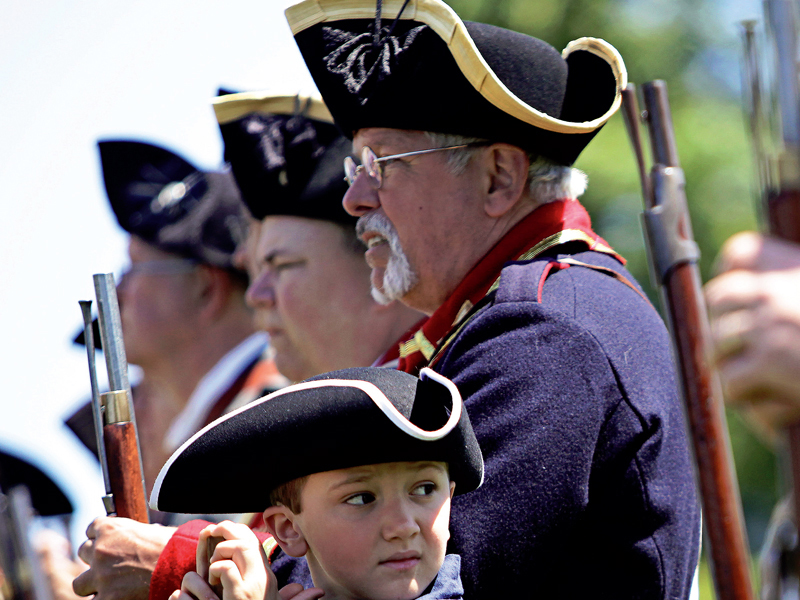
The battle of Bunker Hill, part of the Siege of Boston, took place on 17 June, 1775; re-enactors commemorate the day.
BOSTON GLOBE/CONTRIBUTOR | GETTY IMAGES ©
A TRUE SON OF LIBERTY
History has it that British soldiers in Boston occasionally exhibited their aggression by taking aim at headstones in local cemeteries. They were, perhaps, particularly irked by one Daniel Malcom, whose final resting place is in Copp’s Hill Burying Ground. Malcom’s epitaph calls him ‘A true son of Liberty…an Enemy to oppression and one of the foremost in opposing the Revenue Acts on America.’ The headstone is marred by pockmarks, apparently caused by muskets shot at close range. Not much is known about this great patriot Daniel Malcom, except that he was a local merchant who was arrested for smuggling 60 kegs of wine and brandy into Boston. True Son of Liberty, indeed.
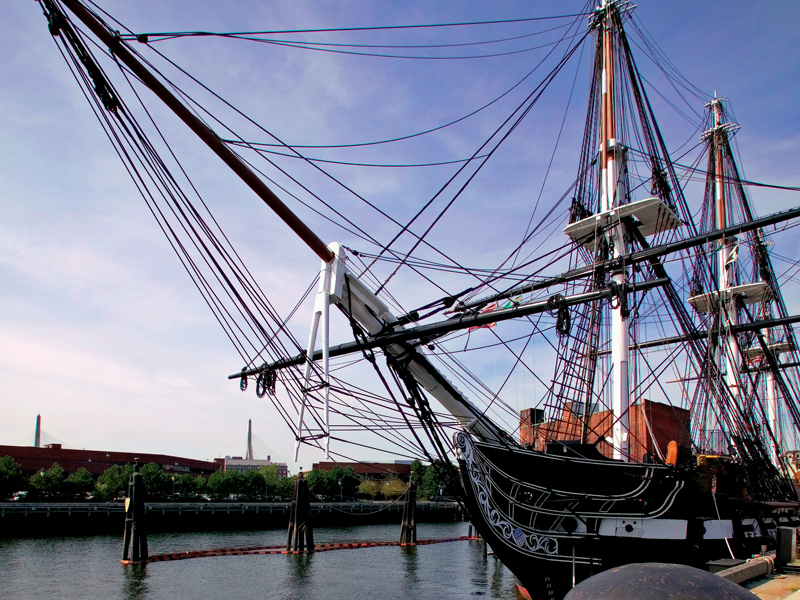
The USS Constitution, nicknamed ‘Old Ironsides’, was built in Boston.
CHUCK PEFLEY | ALAMY ©
INDEPENDENCE DAY
Encircled by cobblestones, the Boston Massacre site marks the spot where the first blood was shed for American Independence. On 5 March 1770, an angry mob of colonists swarmed the British soldiers guarding the State House. About 40 protesters hurled insults, snowballs and rocks. Thus provoked, the soldiers fired into the crowd and killed five townspeople. The incident sparked enormous anti-British sentiment; Paul Revere fanned the flames by widely disseminating an engraving that depicted the scene as an unmitigated slaughter. Interestingly, John Adams and Josiah Quincy defended the accused soldiers in court, and seven of the nine were acquitted.
■ The Perfect Getaway
Boston isn’t called the Cradle of Liberty for nothing. To see where the action went down, follow the Freedom Trail. This 4km walking path winds around the city centre, connecting 16 of the most significant spots. Your children can download an activity-packed Junior Ranger Activity Book (or pick one up from the visitor centre in Faneuil Hall) before starting out. The Freedom Trail is a lot to take in, especially for the younger set, so stick to the highlights. And if things start to fall apart, the Boston Common – America’s oldest public park – has a huge playscape, a spray pool and plenty of wide open spaces where kids can run free.
The Old South Meeting House is the location of the rally that led to the Boston Tea Party. Listen to a re-enactment and let your kids explore the building on a scavenger hunt. For years, Faneuil Hall and Quincy Market were the community’s market place – and they still are, with shops, restaurants and street performers. Visiting them is less of a history lesson and more of a lunch break. Durgin Park is an atmospheric option for old-fashioned Boston fare, like roast beef or fish cakes.
After lunch, stroll to Long Wharf and catch the ferry to Charlestown, on the Charles River’s north bank. It will drop you at Pier 3, near the USS Constitution. The country’s oldest warship, it was launched during the War of 1812. Today, you can take a tour of its decks for a glimpse of life at sea. Your kids can try their hands at firing a cannon or furling a sail at the museum. If they still have energy, head to the Bunker Hill Monument. The young and spry can end their tour by climbing 294 steps to the top of the obelisk for a 360-degree vista of Boston.

Once polluted, the harbour is now clean enough for fishing and even swimming.
TOMAS SZULCZEWSKI | GETTY IMAGES ©
■ Plan It
Boston is a straightforward escape. Logan International Airport is easy to reach by public transport. Accommodation tends to be pricey, but options are plentiful so it’s often possible to score high-quality, centrally located hotels for a bargain online. Many companies offer guided tours of the Freedom Trail, some of which are designed for children: try National Park Service, Boston by Foot and Freedom Trail Foundation.
■ Detour
When your kids are historied out, explore Boston’s connection to the sea. The New England Aquarium (NEAQ) is home to 600 species of sea creatures, from ethereal jellyfish to playful penguins. Highlights include an outdoor marine mammal exhibit, home to some charismatic fur seals, and the Shark & Ray Touch Tank, where your kids can dip a hand in and feel the silky-smooth skin of the sea creatures sliding past. NEAQ also takes whale-watching cruises out to Stellwagen Bank, a rich feeding ground for whales, dolphins and sea birds.
DECKCHAIR
* Make Way for Ducklings (Robert McCloskey) This classic describes the adventures of a mother duck and her ducklings in Boston.
* Willow’s Walkabout (Sheila S Cunningham) An Australian wallaby escapes from the zoo and explores Boston.
* Paul Revere’s Ride (Henry Wadsworth Longfellow, Ted Rand) Longfellow’s famous poem is dramatised by Rand’s vivid illustrations, making it a perfect introduction for children.
* Sam the Minuteman and George the Drummer Boy (Nathaniel Benchley) Chronicle of the Revolutionary War from the point of view of a colonial boy and a British boy, respectively.
* Johnny Tremain (Esther Hoskins Forbes) Follow a colonial-era teenager as he is swept up in the excitement of the Boston Tea Party.
* George vs George (Rosalyn Schanzer) Tells both sides of the story, with great illustrations and text.
GO WILD IN COSTA RICA
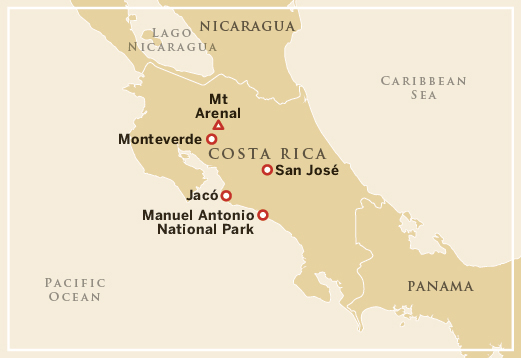
Explore your family’s wild side on a Costa Rican adventure, where it’s possible to see a volcano, hear howler monkeys screeching in the cloud forest, and surf warm blue waters, all in the same day.
ESSENTIAL EXPERIENCES
* Hearing the dinosaur-like call of scarlet macaws before watching them land in a flash of brilliant red on a tree branch at sunset.
* Gliding on a gentle wave while warm ocean water lightly sprays your face.
* Feeling the mist of a 40ft waterfall before seeing it post-descent from the Arenal Observatory Lodge and its volcano views.
* Gaining exhilarating speed as you zip-line through the myriad greens of the rainforest canopy.
* Searching for critters in the mists of Monteverde’s Middle Earth-like cloud forests.
* Getting a touch of vertigo from your very solid bridge, while watching gargantuan sunbathing crocodiles in the river below.
The sound of cicadas fills the forest like a screeching jet engine. You step over a dark trail of leafcutter ants carrying triangles of leaves over a snake-like tree root that’s invaded the path. One of the many tall trees above your head rustles and you look up to see a troop of white-faced monkeys eating fruit. A monkey catches your gaze, then turns quickly to run up the branch, a baby clinging to her back. Your kid points at her, with an expression of pure awe.
Welcome to Costa Rica, arguably the easiest place to see wildlife in the Americas. But the nature-in-all-its-glory adventure doesn’t end here. The same day you explore that forest you may have also visited a live volcano, and the Pacific coast with its sandy beaches and surfable waves could be steps away. As one of the safest and more developed countries in the region, Costa Rica is easy to get around; if you plan it right, you won’t have any car trips longer than three hours. There are thrills for every age: soft beaches for tots, easy walks with lots of animals for kids, more-adventurous jaunts and surfing for tweens, and nightlife and adrenalin-charged activities (from rafting to zip-lining) for teenagers.
While almost anywhere in Costa Rica is good for family travel, the northwest part of the country and the central Pacific coast is easy to get to from the capital, San José, and offers tons of variety in a condensed space. In this exhilarating tropical playland you can explore Arenal’s perfectly shaped volcanic cone and the surrounding Jurassic jungle before heading up to Monteverde for misty cloud forests filled with bright-coloured birds, outrageously large insects and weird animals, like nocturnal, prehensile-tailed porcupines. Then head to the coast for tall, humid jungles that hide sloths, snakes and coatis. Look down from river bridges to see colossal crocodiles bathing in the sun or spend a day at the beach learning to surf in gentle waves. And expect plenty more expressions of awe.
LOCATION COSTA RICA, CENTRAL AMERICA | BEST TIME OF YEAR NOVEMBER TO APRIL | IDEAL TIME COMMITMENT TEN DAYS | ESSENTIAL TIP YOU CAN USE US DOLLARS ALMOST EVERYWHERE IN COSTA RICA | BUDGET $$ | PACK SWEATERS FOR CHILLY NIGHTS, BINOCULARS FOR WILDLIFE-WATCHING, INSECT REPELLENT
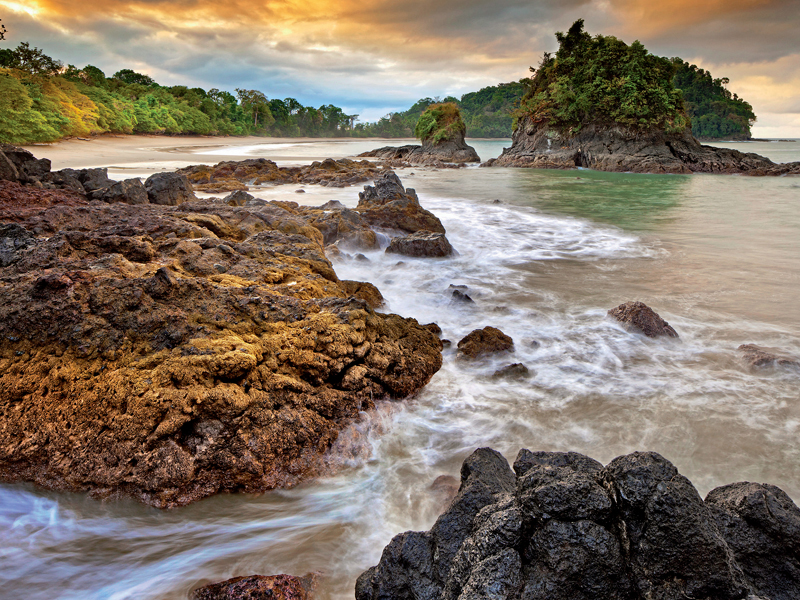
Manuel Antonio is the most popular national park in Costa Rica; continue south to Corcovado National Park for true wilderness.
SLOW IMAGES | GETTY IMAGES ©
COFFEE CULTURE
Cool, highland mountains run down Costa Rica’s interior and hold the country’s often vast arabica coffee plantations. Become a coffee savant on a plantation tour in the Tarrazú province near Jacó or around Monteverde. Start by exploring the plants themselves, from sprout to mature, when the red fruit is picked by hand and gathered in baskets. Then enjoy the aromas while watching the roasting process and learning about the industry’s history. At the end it’s time to learn how to taste the coffee’s nuances – which are only heightened by a view over the rows of plants surrounded by mist-covered jungles.
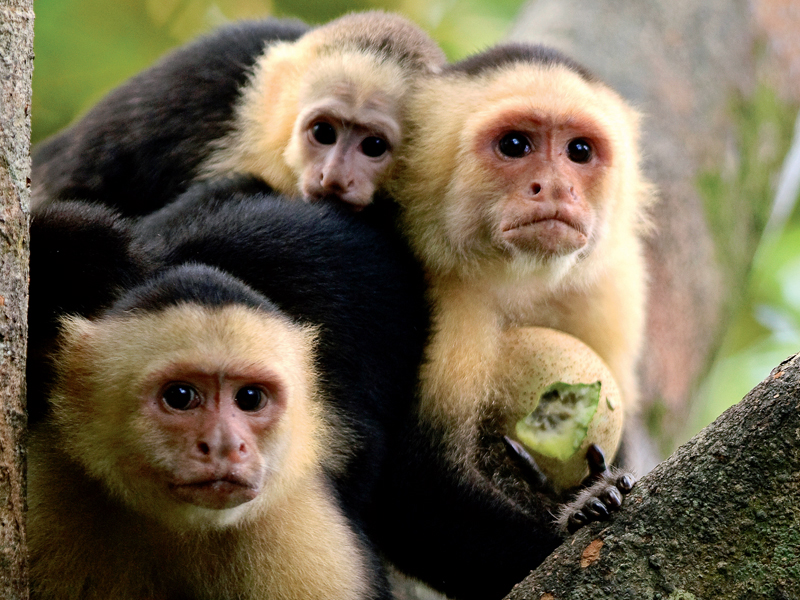
Here come the monkeys: a family of white-faced capuchins.
VISUALS UNLIMITED, INC./GREGORY BASCO | GETTY IMAGES ©
HIGH IN THE CANOPY
Click into the harness, hang on and whooooooop! Zip-lining through the forest canopy in Arenal and Monteverde is a real adrenalin rush, offering another angle on the forests (and open to ages four and over). If hanging from a wire 200m up isn’t your thing, don’t despair: there are also open-air trams and suspension bridges that let you enjoy the serenity of the treetops. Will you see wildlife up here? Not much, but it’s said that 90% of living organisms in the rainforest exist at this level. The beauty is in the details.
■ The Perfect Getaway
Get out of San José – fast – and go straight to Parque Nacional Volcán Arenal. The volcano has recently stopped spouting lava and the views here look like something out of a dinosaur-meets-unicorn fantasy novel. Walk or horseback-ride to waterfalls, explore the dark grey rubble of old lava flows, or windsurf, boat or fish the 85-sq-km volcanic lake. Meanwhile, trees with massive root buttresses hold troops of monkey comedians that will keep you laughing. See some of the world’s most dangerous snakes and colourful frogs up close at the Arenal Eco Zoo.
Next, go to Monteverde for higher, mistier, lichen-draped forests with more critters. Take a walk along the family-friendly Bajo del Tigre trail to spot toucans and agoutis by day or hairy tarantulas hiding in their ground lairs at twilight. There are specialist educational zoos here for butterflies, frogs, bats and snakes that allow you to see and learn about your favourite animals.
Then it’s time to descend from the clouds to the sunny, humid coast. Jacó is touristy yes, but it’s a beachside town with enough sleeping and eating options to keep any family happy. Days can be spent exploring the nearby macaw-filled Parque Nacional Carara. If you haven’t had enough animal and beach action, then Parque Nacional Manuel Antonio, about an hour down the coast from Jacó, is sure to deliver. Here, vine-covered trees harbouring sloths give way to coconut palms and white sands where you can swim in warm blue water until an animal exciting enough (a spiny-tailed iguana, maybe?) draws you out. Again, this park is no secret but it merits its popularity through its beauty and density of animal life. Even at its most crowded it still feels like the monkeys outnumber people.
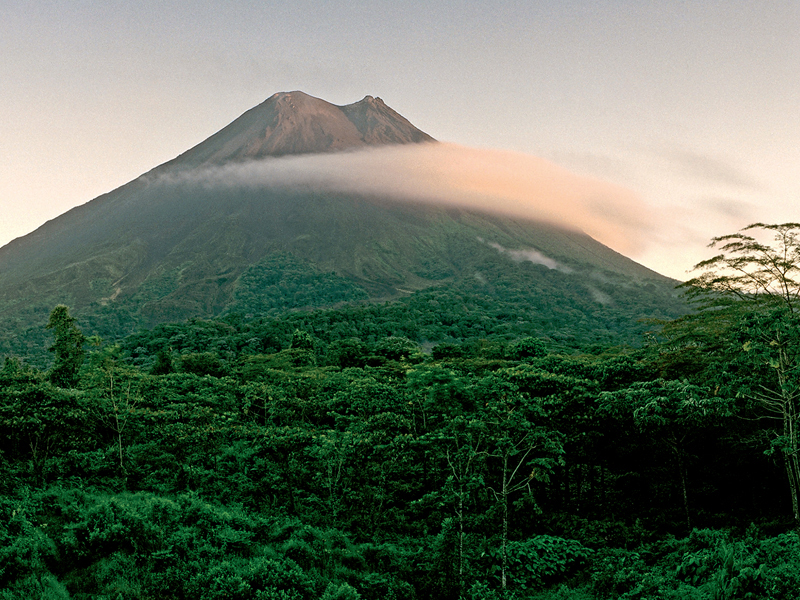
More than a volcano: there are 850 bird species in Arenal National Park.
MACDUFF EVERTON | GETTY IMAGES ©
■ Plan It
Fly into the Costa Rican capital of San José and rent a 4WD. Book your lodging well in advance if you’ll be travelling during the peak months of December and January or June and July. The driest (and most popular) time to visit is November to April. Humpback whales migrate along the coast in September and October. Monteverde gets packed for the annual Monteverde Music Festival (includes jazz, Latin and classical artists), held on variable dates from January to early April.
■ Detour
If you’re travelling in December or January, visit the Playa Hermosa Wildlife Sanctuary to watch baby Olive Ridley turtles dig out of their nests and flail their way to the sea. From July to early December you may be able to visit the sanctuary at night to watch mama turtles come to shore to lay eggs. Any time of year you can visit the hatchery and see the efforts to protect the species. Tour companies can charge up to US$100 per person for day trips but it’s perfectly fine to just show up on your own.
DECKCHAIR
* The Wildlife of Costa Rica: A Field Guide (Zona Tropical Publications) Packable illustrated fauna guide.
* The Old Patagonian Express: By Train Through the Americas (Paul Theroux) Late 1970s train voyage includes Limón and Puntarenas.
* The Umbrella (Jan Brett) Story and detailed art of the Costa Rican cloud forest. Ages four to eight.
* Nancy Drew: The Scarlet Macaw Scandal (Carolyn Keene) Nancy and friends volunteer in Costa Rica and find they have a mystery on their hands.
* The Divide (Elizabeth Kay) A 13-year-old boy falls into a world of legendary creatures while vacationing with his family in Costa Rica..
* Spy Kids 2: Island of Lost Dreams (2002) Filmed on location in Arenal and Manuel Antonio.
SADDLE UP IN BARCELONA
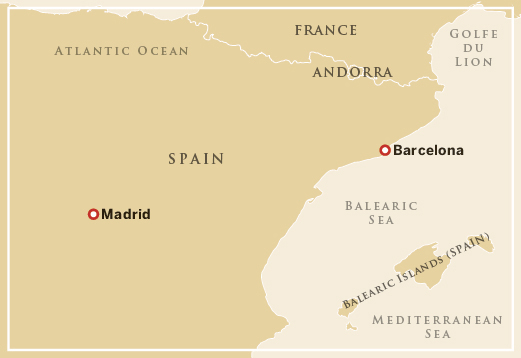
Barcelona is epic on two wheels. Soar up to the Sagrada Familia, squeeze through the alleys in the Gothic Quarter and park and chill at the seaside - there’s no better way for families to pay homage to the Catalonian port than in a team of friendly bicycles.
ESSENTIAL EXPERIENCES
* Witnessing some of Picasso’s greatest paintings in an elegant palace.
* Walking to Joan Miró’s Foundation at Montjuïc hill, where great views join the modern master’s work.
* Browsing at La Boqueria, the colourful food market in the Laval district.
* Posing as Lionel Messi at Camp Nou stadium & museum, Barça FC’s stadium and museum.
* Enjoying the cool, dark corners of La Seu Cathedral.
* Strolling the white walkways at MACBA – the Musem of Contemporary Art of Barcelona – a dramatic, Richard Meier–designed building.
* Cycling through Parc de la Ciutadella, Barcelona’s most elegant park.
* Soaring up the Sagrada Família. Gaudí’s vertiginous masterpiece is scheduled to be completed in 2026. Finally.
Sitting in Parc Guell, on Gaudí’s incredible serpentine mosaic bench, you’ll look down at the panorama of Barcelona with the glittering Mediterranean beyond. Within 20 minutes, you’re chewing pizza in the Barri Gótic (Gothic Quarter), and a short while later, eating ice cream on a baking beach.
And all of this can be done without stepping on a bus or a train, for Barcelona is becoming one of Europe’s most cycle-friendly cities for families. Rent from one of its growing numbers of bicycle-hire shops and you’ll soon be pedalling gingerly down those small, pedestrianised medieval streets, or in the summer sunshine of Barcelona’s cycle-ways. Cycling in Barcelona particularly comes alive on Sundays, when a bike gives you and your children the freedom of the city. Fuel up on a chocolate croissant at a cafe in the hip El Born district, before pedalling across Ciutadela Park to Barcelona’s old fishing quarter, Barceloneta, to witness one of Europe’s great weekly paseos. On one side the area has urban beach; on the other, the dramatic architecture for which the city is renowned; in between, you’ll find yourself part of an endless stream of walkers, roller-bladers and cyclists.
In recent years, Barcelona’s administration has done much to promote cycling. Good news, as there’s something about the city’s pace, the sunshine, the slow traffic and child-friendly restaurants and museums that works well on wheels. Flanked by hills like Montjuïc (the fit are welcome to try), downtown Barcelona is mostly flat, an elegant mix of bisecting boulevards behind which run tangled medieval alleys. There’s a coastline, a few beaches, myriad sights and museums, tapas bars everywhere and the most vivid street life in Europe.
By bike you can cover the sights more rapidly – and have a great time doing so. As Barcelona visitor Ernest Hemingway once put it, ‘you have no such accurate remembrance of country you have driven through as you gain by riding a bicycle.’
LOCATION BARCELONA, SPAIN | BEST TIME OF YEAR HIGH SUMMER IS HOT BUT WITH LESS TRAFFIC | IDEAL TIME COMMITMENT ONE WEEK | ESSENTIAL TIP WATCH OUT FOR THIEVES; BARCELONA’S GREAT DRAWBACK IS ITS ROBBERY | BUDGET $$ | PACK CLOTHES THAT ARE PICKPOCKET PROOF
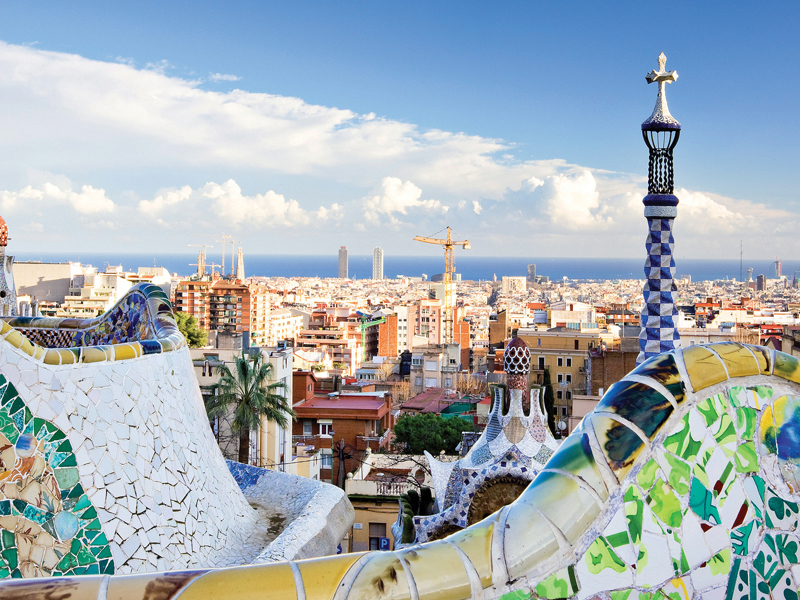
Looking out from Park Güell; Gaudí’s mosaic of a sea serpent will appeal to young and old.
XAVIER ARNAU | GETTY IMAGES ©
BICING BARCELONA
In 2007, Barcelona’s City Council started Bicing, a bicycle-sharing scheme. It’s available to locals only, so tourists have to hire, but the project has opened the city’s eyes to cycling and encouraged many residents to take to two wheels. Meanwhile, Barcelona has opened up its streets, already pedestrian-friendly, to bicycles, with 172km of bike lanes and shared space with cars. There’s even a ‘Bicycle Counter’ on Passeig de St Joan, setting out the goals for cycling in the city. At present there’s a squabble as Bicing has leapt in price, but it seems unlikely that Barcelona’s cycling revolution will abate.
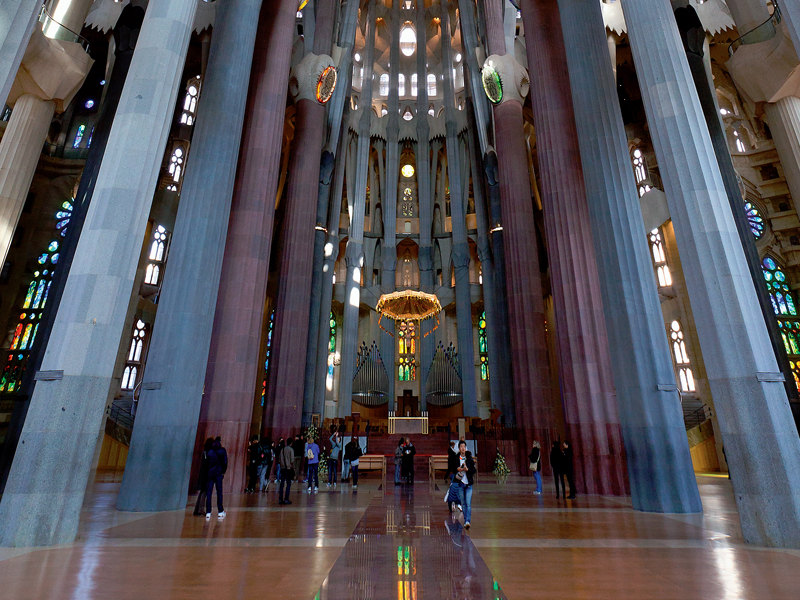
Gaudí worked out how tree-like columns could support the Sagrada Familia’s roof.
SYLVAIN SONNET | GETTY IMAGES ©
GAUDÍ’S BARCELONA
Antoni Gaudí defines Barcelona. This eccentric architect, who died in 1926 in a tragic tram accident, left an unmistakable architectural language of sinewy curves and mosaics that took the idioms of Arts and Crafts and art nouveau a step beyond. Look out for his houses on Passeig de Gràcia, Casa Batlló and La Pedrera. Parc Guell, with its long mosaic bench, is an afternoon’s delight for families and charged with a fairy-tale atmosphere to delight the most art-hating child. And don’t miss his greatest gift to the city, the astonishing La Sagrada Familia cathedral, still unfinished. A lift will take you up the spires for stupendous – if vertiginous – views.
■ The Perfect Getaway
Barcelona has increasing numbers of bicycle hire shops, as well as guided bike tours offering circuits that take in sights like La Sagrada Família, Barceloneta Beach and Gaudí’s buildings. Most start on La Rambla, the heart of the old city. This broad pedestrian boulevard carves a slice from Plaça de Catalunya and the early 20th-century Eixample district to the steamy docks and then to the beaches. Or go the other way along Barcelona’s Passeig de Gràcia boulevard – look out for Antoni Gaudí’s Casa Batlló – leading to the elegant Gràcia district.
On La Rambla, stop at the Boqueria market, take a coffee at a bar, and then edge into El Raval, the district made infamous by Jean Genet in A Thief’s Journal (1949). Although gentrifying with hip cafes, its picturesque alleys can be rough, but on a bike you’ll sail past the city’s saltier characters. Here, visit the Museum of Contemporary Art; while you muse over avant-garde artworks, the children will enjoy the views and walkways. Crossing to the other side of La Ramblas, cycle the Barri Gòtic towards the grand La Ribera district through a grid of medieval streets, taking in sights such as the Picasso Museum, an exquisite display in a rambling old palace. Break out into the Plaça Nova to see La Seu Cathedral, then stop at the El Born district for a hot chocolate and churros (Spanish doughnuts).
Freewheel down to Barceloneta to hit Passeig Marítim – the seafront promenade and Barcelona’s best ride. Later, return to one of Barceloneta’s earthy restaurants, for a flauta (tall glass) of beer and some fried octopus at Can Maño on Carrer del Baluard or La Bombeta on Calle de la Maquinista, where the speciality is bombas, deep-fried balls of mashed potato and minced meat. Rich, yes – but earned.
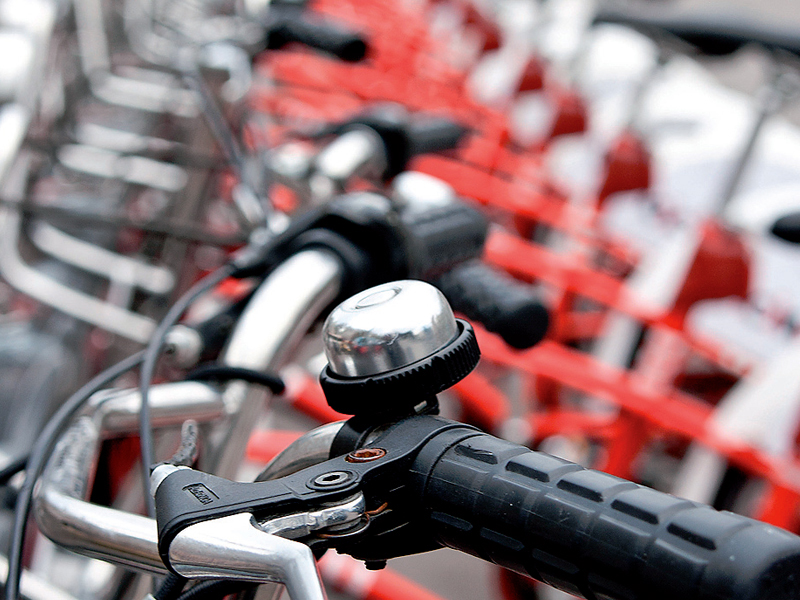
There are 420 Bicing stations.
FAHRETTIN AYDIN YUNUSOĞLU | ALAMY ©
■ Plan It
Summer is hot; most locals leave in August so it’s good for cycling. Spring and autumn are conducive but prone to showers. There are countless bike hire and tour providers. Most visitors enter via El Prat airport. Transfer is easy by train, which connects with the Metro at Barcelona Sants (Estacio Sants), Passeig de Gràcia and Clot stations. An Aerobus alights at Plaça Espanya or Plaça de Catalunya.
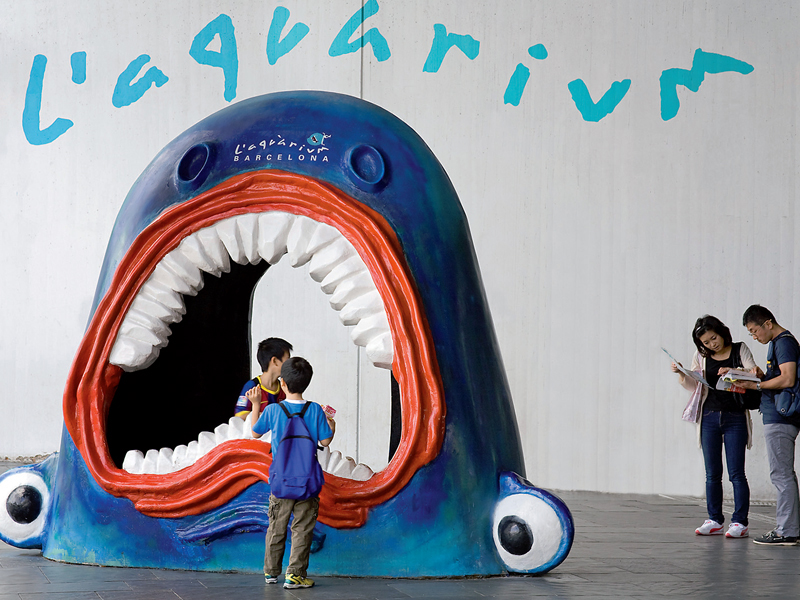
The aquarium has an 80m-long underwater tunnel.
RICHARD CUMMINS | GETTY IMAGES ©
■ Detour
If the children liked Picasso and Gaudí, they’ll love the Teatre Museu Dalí in Figueres, 1½ hours from Barcelona. This shrine to the moustache-sporting surrealist Salvador Dalí is noticeable for its vivid red walls and the eggs on its parapet. It’ll make you smile as soon as you see it. The museum contains a huge collection of artworks, including Dalí’s assemblage made to look like Mae West. To add to the unsettling effect, the artist himself is buried in a crypt in the basement. If you’ve got time, press on to see Dalí’s coastal house in Portlligat and his castle in Púbol, in the countryside.
DECKCHAIR
* Barça: A People’s Passion (Jimmy Burns) This history of the Barça football team is a great accompaniment to a visit to the stadium.
* Barcelona (Robert Hughes) The late Hughes’ pungent prose capivates in this romp through Barcelona’s history.
* Homage to Catalonia (George Orwell) Eyewitness background about the city’s role in the Spanish civil war, and part of Orwell’s political journey.
* Homage to Barcelona (Colm Tóibín) More homage, from the Irish novelist who lived in the city and produced this literate guide.
* Vicky Cristina Barcelona (2008) An artist is at the centre of a love triangle in this Woody Allen Spanish romp.
* Barcelona (1994) A gentle piece from US director Whit Stillman, where US boys meets Barcelona girls with mixed results.
NORTHLAND: NATURE’S THEME PARK
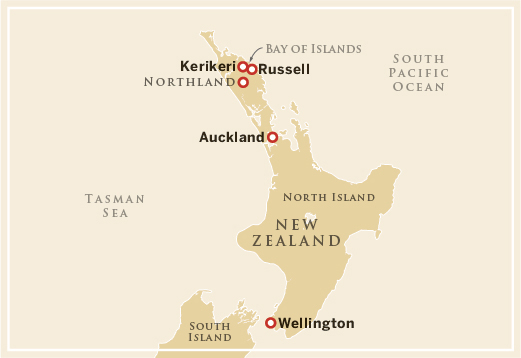
With laidback villages, friendly local wildlife and beaches so clean you could eat your lunch off them, New Zealand’s northern tip is a paradise for families.
ESSENTIAL EXPERIENCES
* Paying homage to the ancient kauri giants of the Waipoua Forest – nothing can prepare you for these mighty trees.
* Exploring colonial treasures in sweetly historic Russell, the small town that was once, briefly, New Zealand’s capital.
* Enjoying the magnificent, peaceful beaches of Matauri Bay, home to the Rainbow Warrior Memorial.
* Delving into history and culture at the Waitangi Treaty Grounds, where New Zealand’s founding document was signed, before claiming your own island paradise in the Bay of Islands.
* Driving along Ninety Mile Beach – paying careful attention to tides! – and up to Cape Reinga and Spirit’s Bay at the country’s top.
With a rhythmic psssh an emerald-green sea laps at a beach of golden sand. Kids dive off a raft moored some 20m offshore. Others start another day in New Zealand by sliding down a huge sand dune towards warm Pacific waters. At the end of the beach people are fishing off the wharf. All is quiet except for birdsong. Sound like paradise? Sure – so long as you call this idyll ‘Northland’.
Northland is the northern region of New Zealand’s North Island. It separates the Pacific Ocean from the Tasman Sea – they crash together at its tip, Cape Reinga – and this narrow, fertile terrain is a natural wonderland. In Northland, locals say, there is no need for Hobbit villages or roller coasters or bungee jumping or whatever else gets pushed as ‘tourist attractions’ in more southern parts of New Zealand. That’s because this magic land is a natural playground, one without height restrictions, queues or junk-food vendors. That makes it a magnet for outdoors-loving families, who come here to lose themselves – or perhaps rediscover themselves – among beaches and forests, up rivers and down sand dunes.
There are few rules. You could spend the morning beachcombing for washed-up treasure on beaches such as Tapeka, in the Bay of Islands, or learn to surf at a sheltered break. When you’re hungry, amble along to a fish-and-chip shop serving the freshest catch of the day. If the weather’s wet, explore local history in the tiny town of Russell, New Zealand’s first capital, or climb to the historic Maori pa (fortified village) at Kororipo.
After hours of play, happy sandy kids with that sun-blushed glow will be ready for an early night, leaving you free to reflect on the day’s thrills and spills. Yes, Northland may be a long way from the rest of the world, but who said that getting to paradise would be easy?
LOCATION NORTHLAND, NEW ZEALAND | BEST TIME OF YEAR SUMMER (DECEMBER TO APRIL) | IDEAL TIME COMMITMENT SEVEN TO 10 DAYS | ESSENTIAL TIP BUY LOCAL ARTISANAL PRODUCTS FROM THE COTTAGE INDUSTRIES SURROUNDING KERIKERI | BUDGET $$ | PACK SUNSCREEN, HAT AND BEACH GEAR
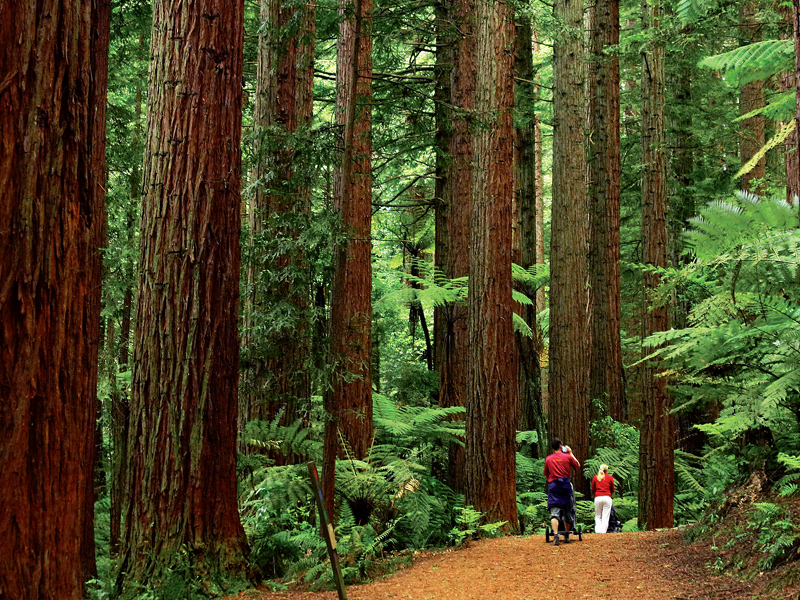
New Zealand’s kauri trees, whose ancestors first appeared 190 million years ago, live in mixed forests.
DAVID WALL PHOTO | GETTY IMAGES ©
THE KAURI FORESTS
Much of the northern part of the North Island was once covered in mixed forest. The king of the forest was the kauri (Agathis australis), the world’s second-largest tree after California’s sequoias. The kauri produce a beautiful timber and were valued by the Maori for their height (to build huge canoes), while Europeans realised they were perfect for furniture and house building. Northland’s Waipoua Forest – preserved in 1952 after much public pressure – is home to three-quarters of the country’s surviving kauri and the best place to see the remaining giants. Today, efforts are being made to grow new generations of the nation’s native tree.

Let’s go surfing: several surf schools operate in Northland, helping youngsters gain confidence in and out of the water.
WILL GRAY | GETTY IMAGES ©
HISTORIC NORTHLAND
The site of the earliest settlements of both Maori and Europeans, Northland is unquestionably the birthplace of the nation. Maori legend holds that the great Polynesian explorer Kupe discovered Hokianga Harbour and encouraged his people to settle there. The fertile lands and warm climate meant European settlers also embraced this land. This lead to early conflicts between the British and Maori, with the likes of the mighty Maori warrior Hone Heke outwitting the British in battle and cutting down the flagpole at Russell four times. Maori pa (fortified village) sites and British colonial buildings still exist across Northland.
■ The Perfect Getaway
A good place to start exploring Northland is Hokianga Harbour. At Omapere – one of several small settlements around the harbour – you can take a boat to some superb dunes, rolling hills of sand that are perfect for tumbling down. (Or, if tumbling is best left to the kids, you can view the majestic landscape.) Driving south of Hokianga Harbour leads to Waipoua Forest. Among this vast native kauri forest – thankfully saved from the timber mills that gobbled up so much Kiwi forest across the 19th and early 20th century – towers Tāne Mahuta (Lord of the Forest), New Zealand’s mightiest tree. Yet the forest is not simply this single totem: there are many giant trees here alongside much younger native forest.
Puketi Forest, which is a more dense and winding wilderness than Waipoua, offers a great way of imagining Aotearoa before humans settled here. Puketi is close to the historic town of Kerikeri; stop for coffee and cake before heading up the coast. Here, Northland quickly gets rural, with small Maori communities living along the shore. While the beaches are magnificent, a special place to stop is Matauri Bay. Driving off the main highway, follow an inland ridge before dropping down into the bay. Owned by the local Maori – so developers have been held at bay – Matauri Bay has a campsite and store, golden beaches and, atop a short, steep hill, a huge stone rainbow. This is the Rainbow Warrior Memorial, by Kerikeri sculptor Chris Booth, and marks the resting place of the Greenpeace ship (now a dive site offshore). Look out for other works by Booth, who has built sculptures out of local stone across Northland, in addition to the Gateway sculpture at the entrance to Albert Park in central Auckland.
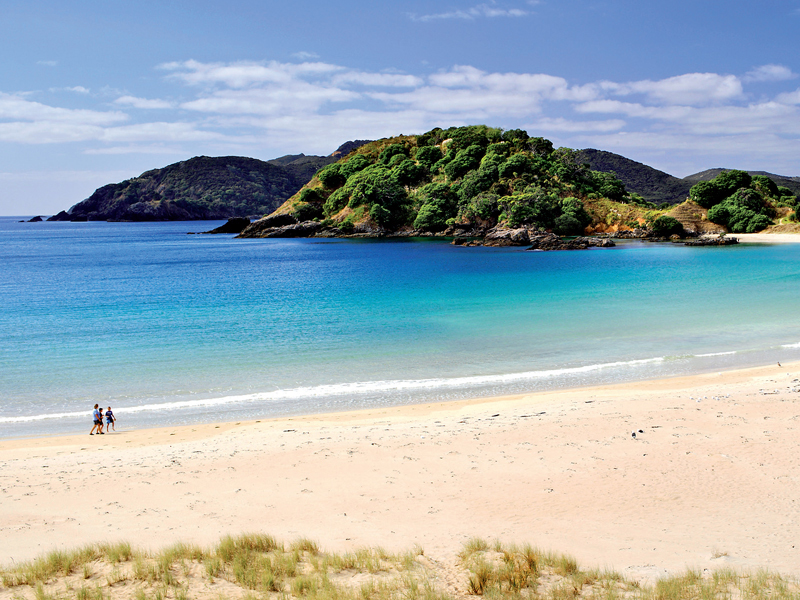
Matai Bay on the Karikari peninsula.
RICCARDO SPILA/SIME | 4CORNERS ©
■ Plan It
International flights land at Auckland; Northland is four hour’s drive north. Kerikeri and the Bay of Islands are the main hubs – buses and planes leave Auckland for Kerikeri every day. Note that the local Maori communities do not wish to be treated as tourist spectacles. Northland is open year-round; while it’s warmer in winter than the rest of New Zealand, even summer can bring rain.
■ Detour
Kawakawa. south of Paihia, is just an ordinary Kiwi town, but its public toilets are anything but. They were designed by Austrian-born artist Friedensreich Hundertwasser, who lived nearby from 1973 until his death in 2000. The most photographed toilets in NZ are typical Hundertwasser – lots of wavy lines decorated with ceramic mosaics, and with plants on the roof. Kawakawa’s other claim to fame is the railway line running through the centre of the main street, on which you can take a spin, pulled by Gabriel the steam engine.
DECKCHAIR
* Sweet As: Journeys in a New Zealand Summer (Garth Cartwright) The London-based Kiwi author returns home to wander New Zealand.
* Woven Stone: The Sculpture of Chris Booth (Edward Lucie-Smith) Beautifully illustrated and informative book on Kerikeri’s most famous son.
* The Penguin History of New Zealand (Michael King) King was New Zealand’s foremost historian and this highly readable book offers up much information on Northland as a major player in the nation’s colonial history.
* Kin of Place: Essays on Twenty New Zealand Writers (CK Stead) Stead, one of the country’s leading novelists and academics, meditates on leading Kiwi fiction writers.
* The Scarecrow (Ronald Hugh Morrieson) Set in a small town, this brilliant coming-of-age murder mystery is true Kiwi gothic.
ON HAMPSHIRE’S JANE AUSTEN TRAIL
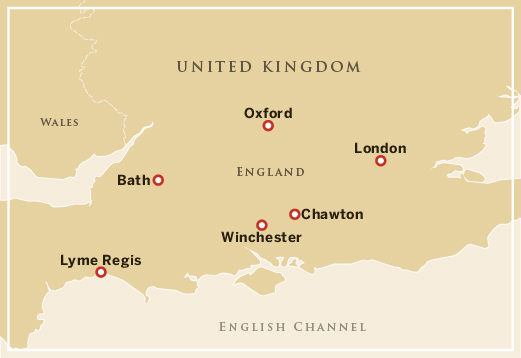
For families who love a good costume drama, this romp around southern England in the footsteps of Jane Austen and her genteel characters will reveal quaint villages, stately houses and steam trains – all within a carriage ride of London.
ESSENTIAL EXPERIENCES
* Perfecting your 19th-century mannerisms.
* Stopping for lunch at a country pub; check the website of the Campaign for Real Ale (CAMRA) for recommendations.
* Going to the seaside and reading an Austen novel on the shingly shore.
* Being pulled by steam locomotive along the Watercress Line from Alresford to Alton.
* Seeing where scenes from movie and TV versions of Austen’s stories were shot.
* Walking or riding part of the South Downs Way; there are viewpoints from Harting Hill onwards to the south.
‘The rooms were lofty and handsome, and their furniture suitable to the fortune of its proprietor; but Elizabeth saw, with admiration of his taste, that it was neither gaudy nor uselessly fine…’ That’s how novelist Jane Austen describes Elizabeth Bennet’s first impressions of Pemberley, the ancestral home of Elizabeth’s love-hate antagonist, Mr Darcy. The book, of course, is Pride and Prejudice, a story that is more inescapable now than it was 200 years ago. It has long exercised the talents of location scouts and set dressers, who scour Britain’s stately homes in their quest for the perfect Georgian drawing room.
But Jane Austen inhabited only a small corner of the country. She was born and lived for a large part of her life in Hampshire, and the southern county’s simple pleasures informed her own tastes and her writing. Her birthplace of Steventon is just a 30-minute drive along lanes from the village of Chawton, where she lived from 1809 to 1817; her red-brick house here is open to the public. Stroll down to the other end of the village to check out Chawton House, whose library has one of country’s finest repositories of women’s literature.
Austen died aged just 41 in Winchester, where she is buried – together with numerous kings of Wessex from a pre-Union England – in one of Britain’s more beautiful cathedrals (from the inside, especially). Make a stop at Alresford on the 30-minute drive from Chawton to Winchester; from here steam trains on the Watercress Line puff their way back to Alton during the summer months.
When outdoor scenes are required, location scouts turn first to Lacock village, just across the county border in Wiltshire, which, with its higgledy-piggledy timbered houses and 13th-century abbey, looks as if it has been teleported here from the Middle Ages. Now conserved by the National Trust, here you can follow activity trails around Lacock’s abbey and grounds or channel Elizabeth and Darcy for a photoshoot in period costume.
LOCATION HAMPSHIRE, ENGLAND | BEST TIME OF YEAR MAY TO OCTOBER | IDEAL TIME COMMITMENT TWO TO THREE DAYS | ESSENTIAL TIP PLAN SUMMER ACTIVITIES AT NATIONAL TRUST PROPERTIES ONLINE | BUDGET $$ | PACK A WINDPROOF JACKET
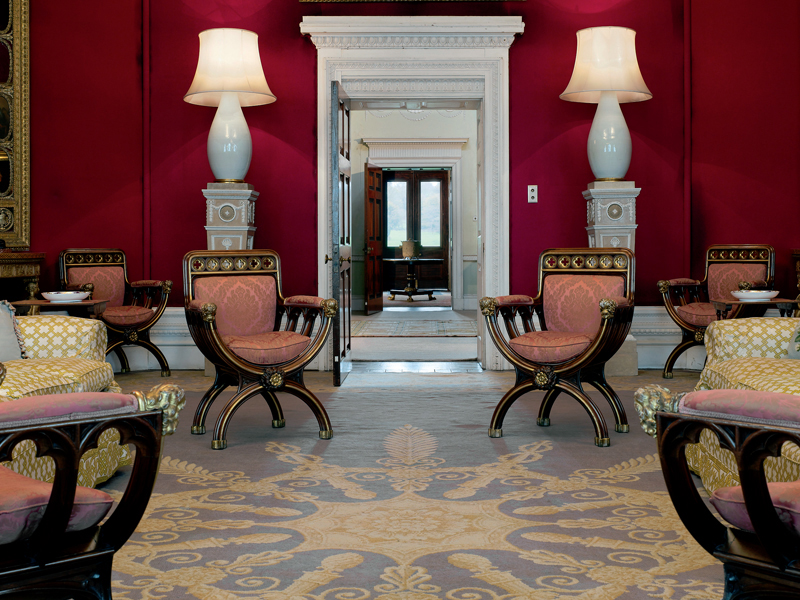
Scenes from a love story: the drawing room at Basildon Park.
DENNIS GILBERT | NATIONAL TRUST IMAGES ©
PRIDE AND PREJUDICE
In 2013, the 200th anniversary of Jane Austen’s most famous novel was celebrated. Of all 18th- and 19th-century England’s great wave of novels – this was the genesis of the genre, in English at least – Pride and Prejudice has inspired the most film and TV adaptations, fan-lit and even mash-ups with zombies. Austen herself described the work as ‘rather too light, and bright, and sparkling’. But for all the formal balls at Netherfield, the mannered chit-chat in drawing rooms and the will-they-won’t-they love story, perhaps the secret to the book’s appeal is that it has a bit of bite: there are satirical barbs hidden in the froth.
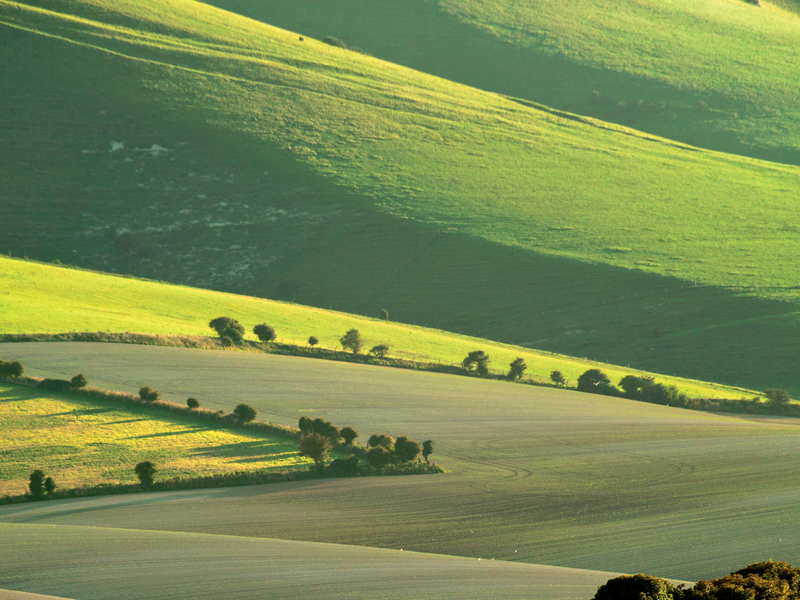
The South Downs National Park remains a working landscape.
SLAWEK STASZCZUK | GETTY IMAGES ©
UP ON THE SOUTH DOWNS
Britain’s newest national park is an undulating chalk ridge reaching 160km from Winchester to Eastbourne on the south coast and covering 1600 sq km. With a highest point of 270m, and a topography rounded by millions of years of wind and rain, the South Downs may not have the height of Britain’s more northern national parks. But what they lack in drama they make up for with a beguiling beauty in the soft light of a summer dawn. The sun shoos away the mist in the ridge’s green folds and glints off the sea, visible from around halfway along the South Downs Way, a long-distance path for walkers and riders running the park’s length.
■ The Perfect Getaway
This is an England far removed from the tourist honeypots of the Cotswolds or the Dales. But there’s an honest charm to the Hampshire landscape. Creases of the chalky land, wooded with beech trees, are known as ‘hangers’; you can follow this line of hills on the Hangers Way footpath through a countryside that inspired Jane Austen. Local naturalist Gilbert White, who lived nearby in Selborne 200 years ago, described the wild appearance of the sunken lanes around Chawton as being five metres below the level of the fields, with tangled roots and icicles cascading down their sides. Such rugged scenes, he noted, ‘affright the ladies when they peep down into them from the paths above, and make timid horsemen shudder while they ride along them’.
But to see where scenes from Austen’s stories have been filmed, you will have to venture out of the county. In Wiltshire, to the west, privately-owned Wilton House starred as Pemberley in the 2005 film of Pride and Prejudice, with Keira Knightley and Matthew Macfadyen as the sparring couple. The property, home of the Earl and Countess of Pembroke, also appeared in Ang Lee’s 1995 adaptation of Sense and Sensibility. North of Hampshire, in affluent Berkshire, Basildon Park played Netherfield Hall in the 2005 Pride and Prejudice. Now a National Trust property, like Lacock village, it was restored by Lord and Lady Iliffe in the 1950s. Both properties are open to the public.
If you have the time to continue on Austen’s trail, venture west to the spa city of Bath, where two of her novels were set. This beautiful Georgian city has Regency tea rooms aplenty in which to wrap up your jaunt.
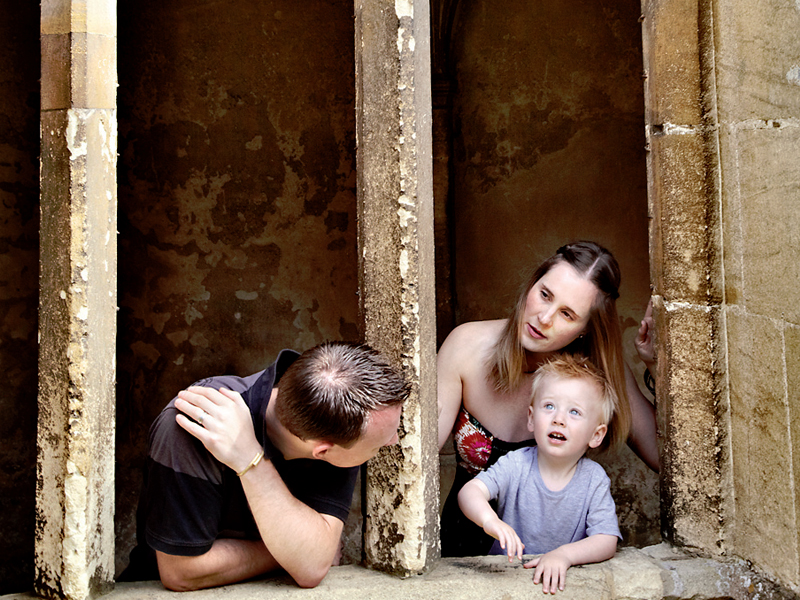
Lacock Abbey and its village host events and activities for families during the summer.
ARNHEL DE SERRA | NATIONAL TRUST IMAGES ©
■ Plan It
All the Austen sites are just two hours by train or car from London. For Chawton, take a train from London Waterloo to Alton. Winchester is also on a direct line out of Waterloo. Gatwick or Heathrow will be the most convenient airports. Trains from Europe arrive at London’s King’s Cross St Pancras terminal. For accommodation, go money-no-object luxe at the Four Seasons Hotel near Basingtoke, or mid-range at the Hotel du Vin in Winchester; there are also many family-friendly B&Bs in the area. Wilton House is open from May to September.
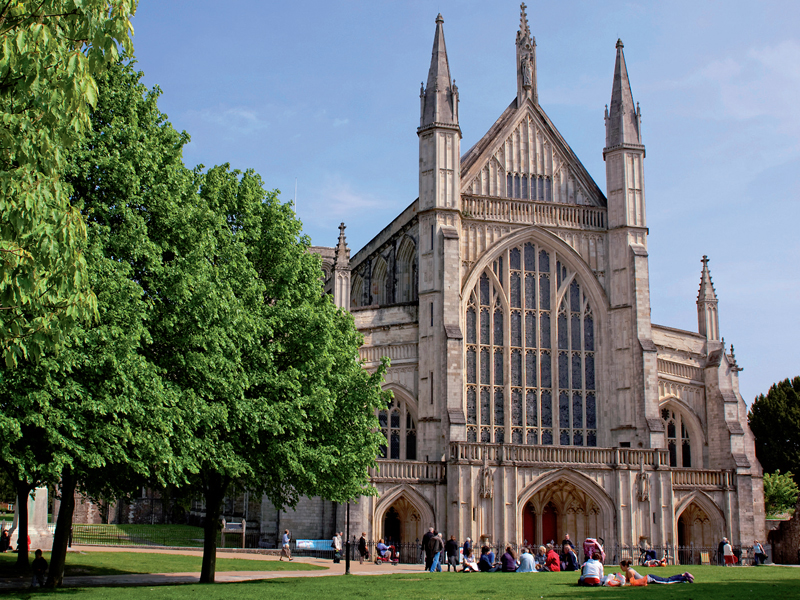
The front entrance of Winchester Cathedral.
DIANA JARVIS | GETTY IMAGES ©
■ Detour
It was to England’s south coast and its louche seaside resorts that Austen’s more wayward characters fled. Copy them by escaping to Lyme Regis in Dorset. Its harbour wall, the Cobb, plays a part in Persuasion and John Fowles’ novel The French Lieutenant’s Woman. And if you’re into food, Dorset is the county for you: TV chef Hugh Fearnley-Whittingstall hosts cookery courses at River Cottage HQ, near Axminster.
DECKCHAIR
* Pride and Prejudice (2005) Keira Knightley purses her lips and a fresh-faced Matthew Macfadyen glowers in perhaps the most successful movie adaptation of Austen’s classic.
* A Natural History of Selborne (Gilbert White) Ground-breaking account published in 1789 of a year in the life of this Hampshire village’s fauna and flora by one of the world’s original naturalists.
* Persuasion (Jane Austen) Jane Austen’s final novel, Persuasion was written entirely at her Chawton house and set partly in Bath.
* Bleak House (Charles Dickens) For some, the Hampshire-born writer’s greatest work, turning on the Jarndyce v Jarndyce lawsuit.
* Watership Down (1978) An animated film about rabbits: the real Watership Down is north of Winchester. Lots of rabbits still live there.
HIT THE SLOPES IN STOWE
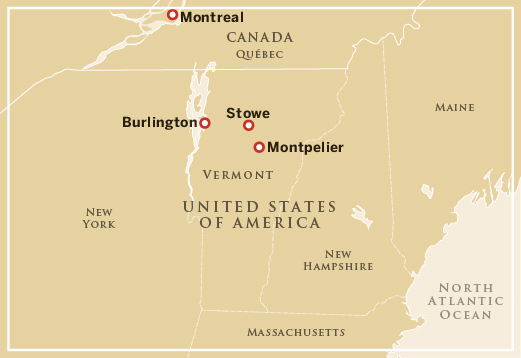
Home to the tallest peak in Vermont (Mt Mansfield), snowy Stowe has a picture-perfect village with an old-timey general store and a surprising array of good places to eat – call it a ski town with benefits.
ESSENTIAL EXPERIENCES
* Going (almost) vertical on a double black diamond trail at Stowe, Smugglers’ Notch or Jay Peak for a hair-raising adrenalin rush.
* Wandering quaint Stowe village for art, history and window-shopping.
* Sipping a house-brewed beer and taking in the mountain views at the Trapp Family Lodge, founded in 1950 and still operated by the Von Trapp family of Sound of Music fame.
* Strapping on snowshoes or cross-country skis and taking to the meandering Stowe Recreation Path or other local trail network.
* Gorging on Vermont’s bounty – be it artisanal cheese, maple-smoked bacon, organic apples or a full farm-to-table feast.
A man sits on a stool playing a banjo and soulfully crooning American folk songs. Behind him, beyond a soaring glass wall, Mt Mansfield stands in all her snow-blanketed majesty. Families, couples and folks of all ages clomp around in ski boots, with red cheeks and beanie-mussed hair. Kids dart about, nibbling vegetable-topped flatbread and locally made cheeses while their parents sip wine by an oversized fireplace. Welcome to après-ski in the lobby of the grandiose Stowe Mountain Lodge, part of the Stowe Mountain Resort. It’s quite the reward after a cold day’s zooming downhill. The best part is that you don’t have to be a hotel guest to indulge.
Lift tickets at Stowe are more expensive than at some nearby hills, but the seemingly endless array of terrain, from beginner runs to double black diamonds to backcountry trails, make for some of the best skiing and snowboarding in northeastern USA.
Stowe Mountain Resort first opened for business in 1934, making this one of the state’s longest-running downhill ski operations. But Stowe village traces its roots back to the arrival of settlers in the late 18th century. Stowe is not one of those ski towns that proudly thumbs its nose at progress: here, among the ’70s-style alpine inns and quaint B&Bs, you might find a new yoga studio or a wine shop specialising in Burgundy. And because of the diversity of things to see, do and eat, Stowe attracts folks looking for more than tons of white powder (though there is that). Some may not ski at all, preferring instead to loll about in one of the local resort spas, go snowshoeing or check out some contemporary art. Even the non-ski-bunnies in the family will never grow bored.
LOCATION STOWE, VERMONT, USA | BEST TIME OF YEAR SKI SEASON IS NOVEMBER THROUGH APRIL, WITH IDEAL CONDITIONS DECEMBER THROUGH MARCH; LEAF-PEEPING IS MID-SEPTEMBER THROUGH LATE OCTOBER | IDEAL TIME COMMITMENT THREE TO FIVE DAYS | ESSENTIAL TIP FOR PRIME LEAF-PEEPING SEASON OR WINTER, BOOK HOTELS AND CAR RENTAL AS EARLY AS POSSIBLE | BUDGET $$ | PACK CAMERA TO CAPTURE SNOWY VISTAS OR SPECTACULAR AUTUMN LEAVES
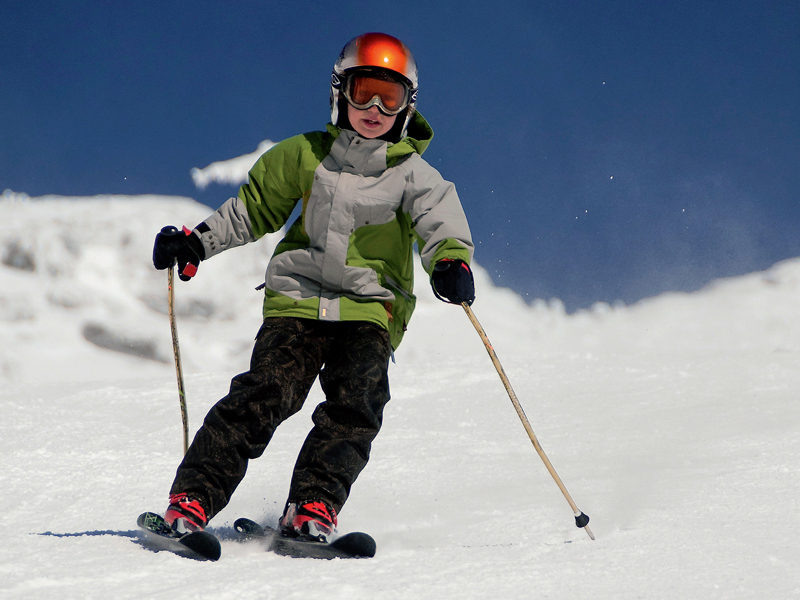
Skiing the Perry Merrill trail: Stowe has seasonal programs for young skiers of all ages.
SUPERSTOCK | AGE FOTOSTOCK
AS AMERICAN AS APPLE PIE
Iconic American illustrator Norman Rockwell lived in Arlington, Vermont, from 1939 to 1953. Many of his well-known portraits of small-town American life – replete with freshly baked apple pies and saluting boy scouts – were made while living here. Though there is a bigger Norman Rockwell Museum in Stockbridge, Massachusetts, where he lived out his final years, the town of Rutland is proudly home to the modest Norman Rockwell Museum of Vermont, housed in a big red barn. It’s filled with kitschy porcelain figurines inspired by Rockwell’s work, prints of his famous Saturday Evening Post covers and plates printed with his illustrations.

Woodstock: when autumn leaves start to fall Vermont is the place to be.
JEFFREY MURRAY | GETTY IMAGES ©
PEEPER’S PARADISE
Just after harvest time, as truckloads of mud-crusted pumpkins invade farmers markets, the forests and mountains here turn technicolour crimson and canary yellow – suddenly the Green Mountain State is aflame with fall colours. The foliage-obsessed flock here in the hopes of hitting that perfect and elusive peak time, when the leaves are at their brightest and most beautiful. Though one windy storm can cut the peeping short, it’s safe to say that prime leaf-viewing time is from about mid-September to late October. Websites like www.foliage-vermont.com track the best regions to visit and offer detailed daily leaf reports throughout the season.
■ The Perfect Getaway
Pancakes: the perfect fuel for tackling a snow-covered mountain? The kids will say so. They’ll delight in the thin, crêpe-like offerings at the wood-panelled Dutch Pancake Cafe, a Stowe institution inside the Grey Fox Inn. After breakfast, hit the slopes. Navigating the six distinct areas of Stowe Mountain Resort is a snap. Beginners and the littlest ones congregate on Toll House, the lowest bit of Mt Mansfield, which is flush with easy runs. Both Lower Spruce Peak, where the ski school is located, and Upper Spruce Peak are well suited to families. Steep Middle Mansfield has the goods for daredevils, while Mansfield Gondola and Mansfield Triple encompass trails for all levels. Those seeking more horizontal thrills can find them on the mountain’s 45km of groomed cross-country trails; visit the information centre in Stowe village for maps of the area’s many trail networks.
When not shredding moguls, set aside time to explore the area’s bucolic surrounds. In the heart of Stowe village, check out the paraphernalia at the small-but-interesting Vermont Ski and Snowboard Museum, or stop into Shaw’s General Store, opened in 1895, selling everything from thermal socks to books by local authors. Tucked away on the 2nd floor of the town library, which was built as a school in 1863, the serene Helen Day Art Center shows contemporary works by local and international artists.
Ice cream is the art form of local boys Ben Cohen and Jerry Greenfield, and in Vermont it’s never too cold for the treat: the Ben & Jerry’s factory in neighbouring Waterbury offers snowshoeing and ice-cream tours from late December to the end of March. Also in Waterbury, the Cold Hollow Cider Mill makes a fun pit stop. Watch the wooden 1920s press pulverise apples into cider, then pick up some jam and cider doughnuts for the road.

It’s not all about the snow: summer fun at Vermont’s lakes.
TARA REESE | GETTY IMAGES ©
■ Plan It
Stowe is a 40-minute drive from Burlington International Airport and a 2½-hour drive from Montreal. Driving the length of Vermont, the sixth-smallest state in the US, takes only 2½ hours, so you’re never far from your next hill or hike. Book a rental car well in advance during peak times (autumn and ski season), and consider opting for a 4WD to handle hills and snow if you’re going to be hopping between mountains.
■ Detour
Jay Peak Resort, a one-hour drive north of Stowe, makes up for its lack of Stowe-style quaintness with its over-the-top, kid-tastic amenities, all part of the massive renovations the resort undertook in 2010–11. Kids of all ages go crazy for the Pump House indoor waterpark where, mercifully, parents have been granted a poolside bar. Had enough splashing about in your swimmers? Rent skates for the whole family and hit the Ice Haus rink. Or stick steadfastly to the hill, where 77 ski trails, tons of backcountry and metres of fresh powder await. And if the kiddies are too young or uninterested to be on the mountain all day, drop-off day care is free for children aged six months to seven years who are staying on-site.
DECKCHAIR
* The Poetry of Robert Frost: The Collected Poems, Complete and Unabridged Four-time Pulitzer-winning Frost was the official poet laureate of Vermont.
* Ben and Jerry’s Homemade Ice Cream and Dessert Book (Ben Cohen and Jerry Greenfield) The Vermont-based ice-cream barons offer up the secrets of their trade.
* Funny Farm (1988) A Chevy Chase comedy about what happens when a couple of New Yorkers move to country Vermont.
* The Secret History (Donna Tartt) This tale of murder at an elite Vermont liberal arts college is a dark and brooding page-turner.
* Phish: The Biography (Parke Puterbaugh) Follow Phish from humble beginnings at the University of Vermont to jam-band superstardom.
* The Trouble with Harry (1955) Alfred Hitchcock paints a loving portrait of quirky, small-town Vermont in this black comedy.
FOLLOW GERMANY’S FAIRY-TALE ROAD
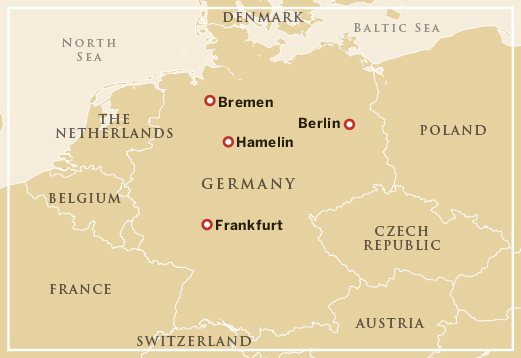
Get behind the wheel of a car (the next best thing to a pumpkin) to ramble along the German Fairy-Tale Route. Its mysterious oak forests, castles fit for a princess and half-timbered towns are straight from the pages of a storybook.
ESSENTIAL EXPERIENCES
* Eating flambéed ‘rat tails’ in the beamed tavern of Hamelin’s step-gabled Renaissance Rattenfängerhaus (Pied Piper House).
* Creating fairy tales of your own beneath millennia-old oak trees in the sylvan wonderland of Sababurg forest.
* Meeting Bremen’s motley Town Musicians: a rooster, cat, donkey and dog. Rub the donkey’s nose for good luck.
* Falling into a deep slumber in a four-poster bed in Sleeping Beauty castle in Sababurg. The bridal suite is reached by a spiral staircase.
* Roaming the 13th-century ruins of Burg Polle, Cinderella’s adopted castle.
* Having your cake, then walking it off on trail after gorgeously wooded trail in the deep, dark and mysterious Black Forest.
Once upon a time there was a very long road that led through enchanted forests of beech, spruce and ancient oak, beloved of woodcutters, wicked witches and industrious dwarves. On and on it went, through medieval towns home to wealthy merchants, passing hilltop castles with ivy-clad towers perfect for locking away maidens with flaxen hair and fair damsels that were a dab hand with a spinning wheel. It was the German Fairy-Tale Route, as seen through the happily-ever-after eyes of the Brothers Grimm in the 1800s.
Want to be whisked away to the faraway kingdom right now? Kein Problem. Why wait for a fairy godmother to wave her magic wand when you can hop on a plane to Frankfurt, minutes from the start of the 600km fairy tale route in Hanau? If you have kids in tow, there’s at least a week’s worth of myths, folklore and bedtime stories to fire little ones’ imaginations and send them happily off to slumberland. If you don’t, and can’t borrow some, you can always act out a few fairy-tale fantasies of your own: losing the trail in misty woods of gnarled 1000-year-old oak and beech trees, cycling along the rivers Fulda and Weser, and cranking up the shining-armour romance with a night spent in a castle.
That the Brothers Grimm lived in and were inspired by this region is unquestionable, but many of the locations on the road are cloaked in a fine weft of fact and fiction. It matters not. This swath of the country is among the fairest of all: its towns and villages are storybook stuff with their timber-framed houses and cobblestones, its forests are a picture of sylvan loveliness, and there is a castle steeped in legend on almost every corner. Walk in the rat-catcher’s footsteps in Hamelin and you might hear the distant strains of a flute; recline on a four-poster bed at Sleeping Beauty’s comfortable castle in Sababurg and you might want to snooze for 100 years. Stranger things have happened…
LOCATION GERMANY | BEST TIME OF YEAR SPRING THROUGH AUTUMN (APRIL THROUGH NOVEMBER) IS MOST POPULAR; BOOK WELL AHEAD IN THE PEAK SUMMER SEASON | IDEAL TIME COMMITMENT ONE WEEK | ESSENTIAL TIP TRAVELLING BY CAR IS A DEFINITE BONUS | BUDGET $$ | PACK BREADCRUMBS TO MARK YOUR TRAIL

If you go down to the woods today: Harz National Park is a 2hr drive east from Hamelin
AVTG | GETTY IMAGES ©
FAIRY-TALE EVENTS
Time your visit to catch one of the region’s fairy-tale-themed plays, festivals or pageants. From Easter to October, Burg Sababurg stages courtyard plays of Sleeping Beauty, while Polle’s medieval castle ruins are an evocative backdrop for the monthly rendition of Cinderella from May to September. The big deal in Hanau is the Märchenfest (Fairy Tale Festival), with Grimm fairy tales performed in an open-air amphitheatre from May to July. Burg Trendelburg hosts its own Märchenfest in May, where Grimm characters are mixed with medieval jousting, acrobatics, music and markets. The Märchenweihnachtsmarkt (Fairy Tale Christmas Market) brings festival sparkle and Grimm folklore to Kassel in December.
■ The Perfect Getaway
Little Red Riding Hood had no say in it, but her neck of the woods allegedly reaches north of Alsfeld, a town fit for a fairy tale with its ensemble of timber-framed houses, cobbled alleys and a silver-turreted town hall. In the 17th century Märchenhaus storytellers recounted the tale of Grandma and the greedy wolf. It’s hard to lose the path in forested Wildpark Knüll, a 40-minute drive north, where kids can spot wolves, deer, beavers and lynx in near-to-natural surrounds.
To visit Snow White’s fictional abode, head east to Bergfreiheit, perched in wooded hills above the spa town of Bad Wildungen. Her ‘house’ is a beautiful half-timbered affair, with seven little beds for her sidekicks. The real draw, however, is a tour of the Besucherbergwerk Bertsch, where you can walk hi-ho-style through the tunnels of a former copper mine, mined by hand for 450 years.
Two fabled beauties of the Grimm world are linked to the town of Trendelburg. The first is Rapunzel, who, lore has it, was locked in its whimsically turreted tower. Get here at 3pm on a Sunday to help Prince Charming find the girl of his dreams (she’s hard of hearing) and watch her let down her lustrous tresses. Nearby is 14th-century Schloss Sababurg, every inch the Sleeping Beauty castle. There may be some truth in the legend: when the castle awoke from a century-long slumber in 1957, it was indeed overgrown with rose brambles.
Edging north, rats rule the streets of the picture-book town of Hamelin, just as they did in the Pied Piper’s day. Rat symbols mark pavements and shops are stuffed with cute, furry rodents. For a historic twist on the story of the flute-playing rat-and-child-catcher, visit the recently revamped town museum.
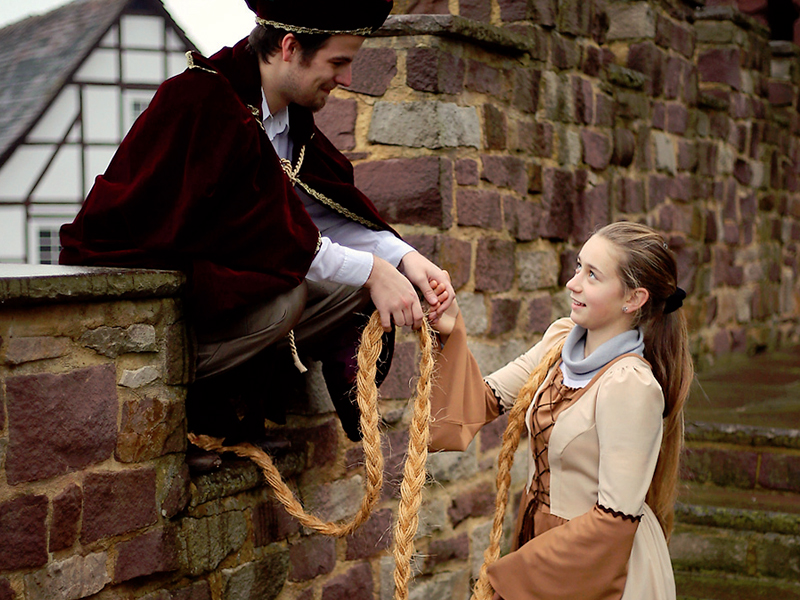
Rapunzel lets down her long, golden hair (again!) at Trendelburg Castle.
SEAN GALLUP/STAFF | GETTY IMAGES
■ Plan It
The German Fairy-Tale Route stretches 600km from Hanau, near Frankfurt, to Buxtehude, near Hamburg. Frankfurt Airport is a 30-minute drive west of the start. By train, Eurostar serves Cologne. Driving is easiest, though major towns along the route are connected by train. Spring to autumn is the best time. Book accommodation on www.deutsche-maerchenstrasse.com.

Bremen, setting for a Brothers Grimm tale about a group of four-legged musicians.
BJORN HOLLAND | GETTY IMAGES
■ Detour
If you’re a sucker for a fairy-tale setting, continue to the Black Forest, a swath of fir forest, lakes and low mountains in Germany’s southwest. The region is set up for family outdoor activities, with back-to-nature farmstays giving kids free rein in beautiful surrounds; visit www.urlaub-bauernhof.de for details. Towns with a fairy-tale focus include Triberg, home to the world’s biggest cuckoo clock; half-timbered Gengenbach, where a scene from Charlie and the Chocolate Factory was filmed; and Villingen-Schwenningen, where mythical giant Romäus guards one of the medieval gate towers.
DECKCHAIR
* Grimm’s Complete Fairy Tales (Jacob and Wilhelm Grimm) The definitive collection for fans of German folklore.
* The Pied Piper of Hamelin (Jacob and Wilhelm Grimm) Rats, flutes and rivers abound in this children’s classic.
* The Hard Facts of the Grimms’ Fairy Tales (Maria Tatar) Explores the dark side of the Grimm fairy tales, from murder to cannibalism. A book for grown-ups.
* The Bremen Town Musicians (Jacob and Wilhelm Grimm) An unwanted donkey, dog, cat and rooster become street musicians.
* Romantic Fairy Tales: Goethe, Tieck, Fouque and Brentano (Carol Tully) A different take on the German fairy tale, this time from the country’s famous Romantics.
* The Interpretation of Fairy Tales (Marie-Louise von Franz) Delve into the psychology of fairy tales to find their deeper meanings.